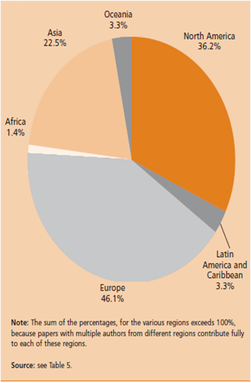|
Some statistics about Uganda, from the U.N.: 38% of the population lives on less than $1.25 per day; the literacy rate is 73%; the life expectancy is 58; infant mortality is 9X that of the U.S. Only 15% of the population has access to electricity. So what exactly is the point of sending science experiments to a country like Uganda, a country that clearly has pressing basic health, education, and energy needs? Some other facts: Africa, a continent of more than 1 billion people, was the origin of less than 2% of global scientific publications and 0.1% of patents granted by the U.S. Patent Office. And here are some other statistics from the U.N.: industrialized countries have between 20-50 scientists and engineers per 10,000 people. In developing countries like Uganda, that number is more like 1 scientist and engineer per 10,000 people. It has been said that developing countries do not have the critical mass of technically skilled workers needed to advance their economies. There is an ever-increasing knowledge gap in the world. Developing countries such as Uganda are continuously placed in the position of importing equipment and technological know-how, ever-dependent on other countries. At the same time, universities in Uganda are filled with bright, eager students ready to learn the latest technological advances - and there will be more to come, as 48% of Uganda's population is under the age of 14. Universities in Uganda are unable to provide opportunities for their students to learn the latest technological advances. The story is the same for the rest of the least-developed African nations. Universities largely lag behind in the latest research because they do not have the latest technology and infrastructure; these are expensive, and require significant training. Therefore, there is a glaring research gap between these universities and those of the developed nations. SciBridge would like to bridge this gap as much as possible by exposing students of African universities to the latest, novel science experiments. In addition, SciBridge aims at developing a strong collaboration network between African and U.S. universities. Over the past 60 years, it has been estimated that on the order of one trillion U.S. dollars has been sent from the U.S. and Europe for aid-related projects in Africa. On the whole, however, countries in Africa have not been able to reap economic benefits from, and thus be able to move beyond, this aid. The SciBridge project aims for a different strategy for African development. Started as a U.S./Africa collaboration and headed by academic scientists, we aim to enable African scientists and engineers at the university level to innovate in their own countries. We believe this is necessary for sustainable development in a continent that is expected to contribute significantly to the global population growth in the coming decades, a population growth that will come with increased energy demands. It is in the global interest to ensure that no matter where they are geographically, brilliant scientific minds are allowed to innovate, particularly when it comes to the energy crisis. This is the reason for SciBridge. World shares of scientific publications in 2001. Source: UNESCO Scientific Report, 2005.
1 Comment
Alex Bataller
8/18/2014 03:59:42 am
"It is in the global interest to ensure that no matter where they are geographically, brilliant scientific minds are allowed to innovate, particularly when it comes to the energy crisis."
Reply
Leave a Reply. |
Archives
February 2023
|


 RSS Feed
RSS Feed
